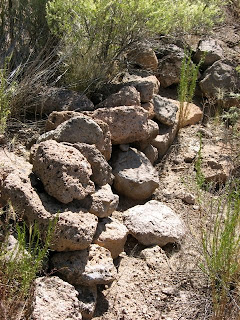 A couple of weeks ago I joined Friends of Archaeology once again for a trip to Otowi in Pueblo Canyon.
A couple of weeks ago I joined Friends of Archaeology once again for a trip to Otowi in Pueblo Canyon. Our trip was led by Office of Archaeological Studies (OAS) archaeologist Steve Lakatos, accompanied by OAS archaeologist Chuck Hannaford, ceramicist Dean Wilson, archaeobotanist Pam McBride, and San Ildefonso Pueblo representatives Bryan and Clarice Montoya.
 Otowi or Potsuwi'i (gap where the water sinks) is an ancestral Tewa village, located along the north side of Pueblo Canyon. While many folks pass by this area on the way to Los Alamos, it has not been easy to visit. It was previously part of the lands appropriated by the Federal government for the Los Alamos National Laboratories, and then it was transferred to Los Alamos County. San Ildefonso expects the area to be restored to tribal governance later this year, and then it will most likely be closed to the public.
Otowi or Potsuwi'i (gap where the water sinks) is an ancestral Tewa village, located along the north side of Pueblo Canyon. While many folks pass by this area on the way to Los Alamos, it has not been easy to visit. It was previously part of the lands appropriated by the Federal government for the Los Alamos National Laboratories, and then it was transferred to Los Alamos County. San Ildefonso expects the area to be restored to tribal governance later this year, and then it will most likely be closed to the public.So it was very exciting to have this chance to tour the site! It was, however, a very hot day, and we probably walked at least four miles. FOA is very good about making sure everyone carried enough water--2.5 litres (which is heavy!) Our lunches were made (including fresh-baked sandwich bread) by the Totavi Café and were excellent. (At least we didn't have to carry those!)
For a general history of the area, check out my recent Tsankawi post. (Otowi is only about two miles away from Tsankawi.)
The various ancestral sites within the canyon now consist primarily of semi-cleared areas, mounded dirt areas, and rocks that were used in construction. When these residences were built (some as early as the 13th century) they were likely not intended for permanent use, and once they were no longer lived in, they "melted" back into the ground pretty quickly. The Pajarito Plateau was abandoned by the Tewa as a residential area by 1550; most went to settle along the Rio Grande where they still live today. However, the area still continued to be used for hunting and worship.
The first photo above shows a pile of volcanic rock that was used in construction; the second shows the rocks that were positioned for the corner of a dwelling--still in place. There is evidence on the site of hundreds of rooms, and 10 circular kivas.

Although we did not explore the "cavates" at Otowi (as we did at Tsankawi), we got a good view of them from the canyon (see the photo above). And we saw the place where the water sinks--a running stream disappears underground (on the way to lunch, and too hot and tired to backtrack for a photo!).
2 comments:
Have you read the two books about Otowi crossing: "The Woman at Otowi Crossing" by Frank Waters and "The House at Otowi Bridge" by Peggy Pond Church? I've read both many, many years ago and enjoyed both.
Kate--I've read "The House at Otowi Bridge" which I enjoyed. You can see the remnants of the house right off the highway on the way up the canyon. It was so isolated in the book--now you could throw a stone at it from the highway.
Post a Comment